Ch. 17 in F/R text:
- mod 56 Human Disease
- mod 57 Toxicology and chemical risk
- mod 58 Risk Analysis
Module 56 Human Disease
Bacteria
e.coli in produce/food: summary
- 1992 Jack in the box-CA, 700 infected, 3 died
- 2002 ConAgra beef, recalled 19 million pounds of beef
- 2005 California spinach
- 2015 Chipotle restaurant
- 2017 IM Healthy granola
Key terms:
Disease: impaired health
Infectious disease: caused by agents-"pathogens"
Acute (sharp) vs. chronic disease
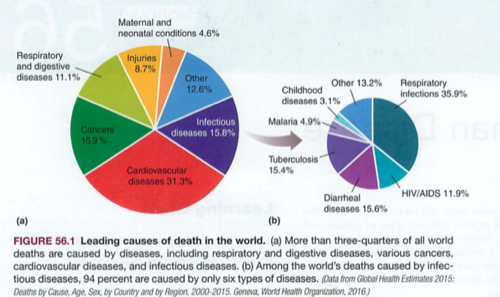 |
|
Click for full-size image |
Note global rate of cardiovascular/heart disease (red), usually preventable
Pathways (vectors)
"Vector" in physics means magnitude and direction
In APES, we usually mean something (a "pathogen") that carries disease:
Epidemic: rapid increase in disease (think of epidermis, the top layer of your skin)
Pandemic: entire continent or world (COVID19)
Plague: bacterium from fleas (modern antibiotics can cure this if given in time)
Malaria: from the Spanish for "bad air", also why Buenos Aires is such a nice place. Plasmodium in blood, no cure, just cure for symptoms. Once you have it, you have it for life, and it can recur.
Tuberculosis: airborne bacterium (like in Les Miserables), very contagious, modern threat is from drug resistant TB, esp. in Russia (selling antibiotics for alcohol)
Emergent infectious diseases:
AIDS/HIV: first seen in early 1980's (along with certain music and hair)
First showed up in babies, homosexuals and blood transfusion recipients
No known cure, but can be managed. Drugs are expensive, so this is still a threat in Sub Saharan Africa, among other places.
HIV mutates to avoid the immune system, and folks usually die from opportunistic infections, like pneumonia
Ebola: Hemorrhagic fever, about 90% fatality rate, very contagious, from primates originally in Africa
Mad Cow disease (
bovine spongiform encephalopathy): "prion" protein pathogen, basically a toxic protein that survives cooking, originally found in UK, banned all beef from there for a certain time in 1996.
Caused by using ground up sick cows as feed for other cows (gross!)
Influenza A viruses:
Swine Flu, Bird Flu H5N1: both jumped from animals to humans (like Covid-19). If this jump is not human-to-human transmitted, then only a few humans die, if it jumps or mutates, then things get serious.
H5N1 refers to the histology (H) and nucleotides (N) in the virus, so we can discern it from others
18000 deaths in 2009 from swine flu
Coronaviruses:
SARS: Severe acute respiratory syndrome, 2002, 10% fatality rate, air transmission,
coronavirus
All boarders from Asia were kept at HPA for the year due to this breakout in Asia
person to person transmission, 8000 infected, 10% fatality rate
MERS: another coronavirus in 2012, ME stands for Middle East, 34% fatality rate (!)
COVID-19: SARS-CoV-2: Coronavirus, airborne and contact on surfaces (perhaps through food), mutating now with "variants" with different internal and spike protein structures.
Named COVID for CoronaVirus
President Biden says by April 19, 2021 90% of you (over 16) will be vaccinated.
3.31.21 news: Pfizer vaccine 100% effective for kids 12-15
Vaccines are either binary or solo (Johnson and Johnson), based on testing not on structure
Vaccines prep the immune system by mimicking the spike proteins on COVID-19, one reason you have an immune response.
Deb Birx the COVID coordinator in 2020 now says 400,000 deaths could have been prevented with masking (disinformation)
#3 cause of death in 2020 behind CV disease and cancer
"Long COVID". patients have many long term challenges, some have seen vaccine improves their outcome even after exposure
Exposure impacts everything in the cardiovascular system, and kidneys, as it attacks the lining of blood vessels and the angiotensin pathway that regulates blood pressure
2 day latency period (no symptoms, asymptomatic)
Note loss of smell, confusion and kidney impact, some are thought to be permanent
Fatality rate varies with age and pre-conditions, about 8% in early cases
Mechanism:
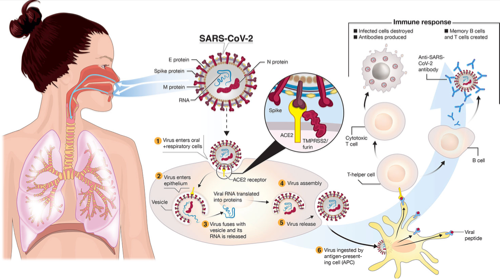
Others:
West Nile virus: in birds from mosquitoes, to humans, causes brain swelling
Lyme disease: from deer ticks, incidents are further north now due to global warming
Zika: pathogen causing babies brains to be damaged/small
Module 57 Toxicology
6 Main chemical toxins:
Neurotoxins-disrupt the nervous system, e.g. insecticides, lead, mercury
Carcinogens-cause cancer, e.g. dioxin, PCB, many others
Mutagens-cause mutations and often cancers, e.g. radon, asbestos, formaldehyde, tobacco
Teratogens-cause birth defects, e.g. mercury, thalidomide, alcohol
Allergens-cause allergic reactions, e.g. dust, pollen, animal dander
Endocrine disruptors-interfere with hormones, e.g. BPA
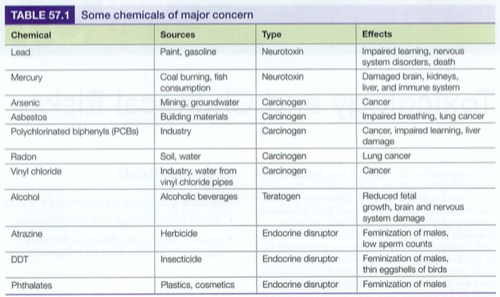 |
|
Click for full-size image |
Note the heavy metals (mercury, lead, arsenic) the artificial chemicals (PVC, VC, Alcohol, phthalates) and the pesticides (atrazine, DDT).
Asbestos is a natural fiber, used in places that can cause cancer through inhalation in humans (insulation, flooring, etc.)
Radon occurs naturally, and concentrates in lower dwellings or in the lower lobes of your lungs.
Allergens: not usually taken seriously, but are often synergistic with toxins above (you may have some)
Endocrine disrupters: can interfere with growth, metabolism and others, often estrogens or similar
Can be hormone blockers or hormone copies (hormone mimicry)
Dose response studies: acute or chronic, seeks to find an LD50 or an ED50 (non-lethal)
LD50 means lethal to 50% of the test population
ED50 means non-lethal impact on 50% of the population
Test data is surmised to be linear, but often not so, e.g. drugs for the aged are not cleared by their liver/kidney as effectively, so blood levels of the drugs increase.
THC decay curve: if half life is 8 days, make a graph of dosing every 4 days
NOEL: no observed effect level-non-lethal impact
Bioaccumulation: A single organism, collecting in fat tissues (PCB, dioxins) or muscles (mercury)
Biomagnification: MANY organisms eaten by an apex predator, increasing the level of a toxin, e.g. you eating Ahi, getting mercury poisoning: See Jack Black and Sushi.
POPs: persistent organic pollutants (carbon based): note half lives
n.b. roundup was recently banned in CA and EU, suspected of causing cancer
Module 58 Risk Analysis
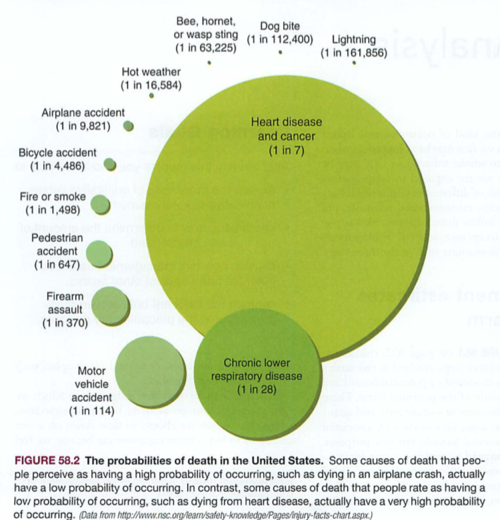 |
|
Click for full-size image |
Note difference between lightning and heart disease...
Risk = probability of exposure x probability of being harmed
Probability of exposure example: is you live in Nebraska, not much risk of sharks
If you surf in Hawaii, different story
Probability of being harmed: flying is safe, but if the plane crashes, fatality rate is around 100%
-----------------
Withgott (author of our Froggie iBook)
Sixth edition of his text, chapter 14 notes:

APES withgott 6e.14
BPA-bisphenol-A Water bottles, food, baby bottles, tupperware
Endocrine disruptors: what are they, how do they work?
BPA is an estrogen analog: https://en.wikipedia.org/wiki/Bisphenol_A
Hormone mimicry:
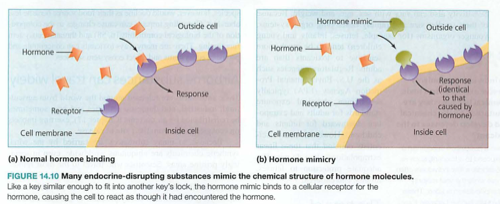 |
|
Click for full-size image |
Possible impacts of hormone disruptors:
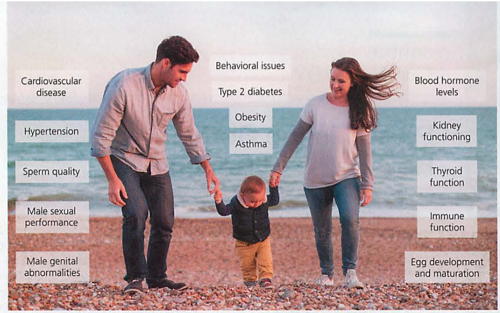 |
|
Click for full-size image |
4 Hazards:
- Physical e.g. UV radiation (DNA damage)
- Chemical e.g. drugs, pesticides, venoms, synthetic and natural
- Biological e.g. infectious diseases (vectors)
- Cultural e.g. smoking, COPD, seat belts, hang gliding, swimming with sharks
Non-infectious diseases: genetics + environmental factors, e.g. cancer, heart disease, obesity
Infectious diseases (ID): ebola, influenza, AIDS, SARS, Covid-19
These spread much faster due to air travel, trains, trucks (see AIDS in Africa, bubonic plague, SARS)
Kinshasa "AIDS highway" https://en.wikipedia.org/wiki/Kinshasa_Highway
Toxicology-chemical hazards
Radon: 226 mass, stays in lower lobes of the lungs, found in basements where Uranium ores are present (Colorado, Alaska)
Asbestos: fibrous non-burning insulating material, mined for ages as an insulator, tabletop, flooring, insulation. Fibers in the air cause asbestosis in the lungs, and various forms of lung cancer (carcinoma)
lead: used in many manufacturing processes, batteries, plumbing/solder, gasoline (yes, gasoline as tetra ethyl lead), causes brain retardation (see romans and lead), replaced in gasoline by MTBE, which causes cancer.
PBDE (polybrominated diphenyl ethers) fire retardants (e.g. TRIS), PBDEs are also hormone disrupters
Risk vs. reward (see malaria and DDT)
VOC in drinking water, also atomizers (like in some classrooms)
Heptachlor in green chop hawaii
EDB in water on Oahu (ant poison)
DDT-foggers in 1960’s….
Toxins
Carcinogens-cause cancer, long term or short term
Mutagens-mutate you or your kids (reproductive DNA)
Teratogens-cause birth defects: fetal alcohol syndrome (huge in Russia), thalidomide
Neurotoxins-mercury and other heavy metals (Minamata Bay), many derived from insecticides
Allergens-airborne or food borne
Pathway inhibitors-endocrine disruptors, BPA, Phthalates (plastics)
Exposure can be acute (short) or chronic (long term)
Bioaccumulation-A single creature
Biomagnification-MANY trophic levels, MANY creatures (see below)

Dose response analysis: determining the dose to have some sort of immediate impact, usually on test animals, but can also be part of a "natural experiment" where something happens to a human or other population, not planned, but well documented.
LD50 and ED50 (not the same)
LD50 is the dose that kills 50% of the population, so LD50 means "lethal dose to 50%"
ED50 is the effective dose (ED) in a test, which can be good or bad: good might be aspirin, but usually it means amount to cause some non-lethal effect, like mice losing their hair.
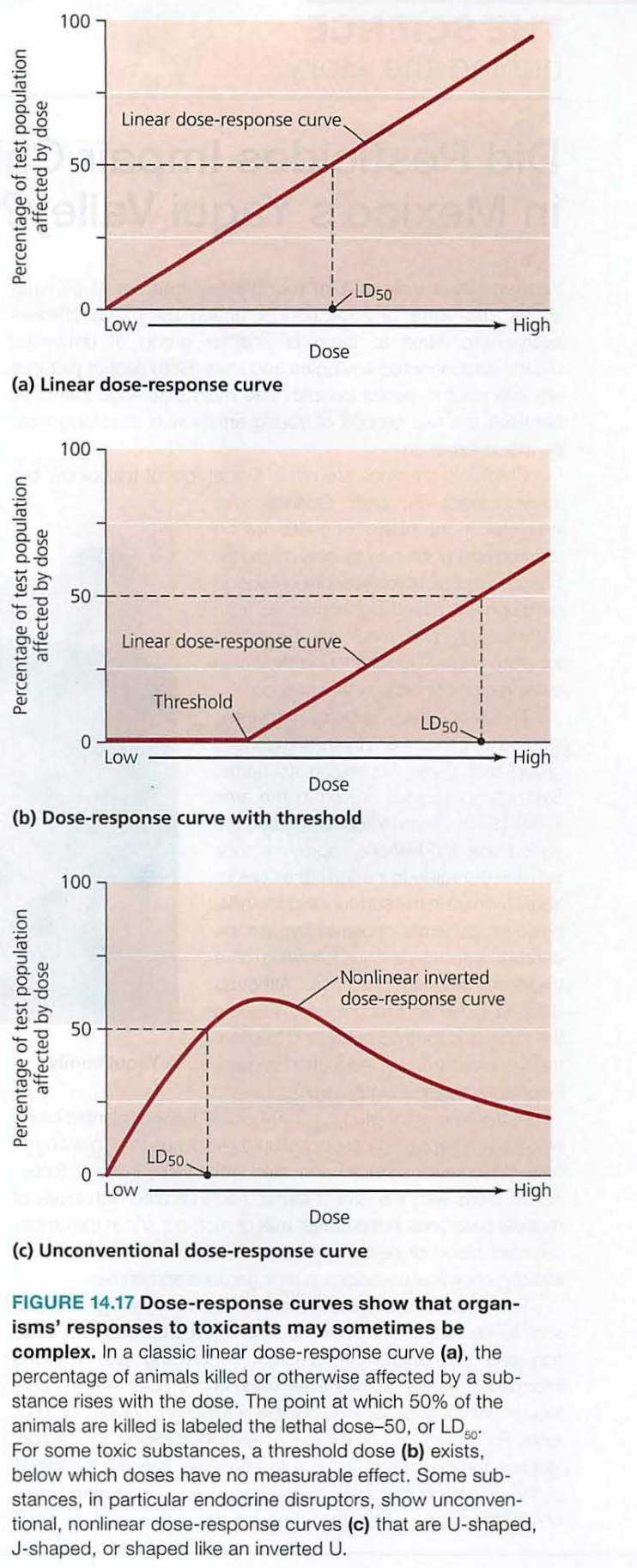
Threshold dose (non linear)
Pesticide poisoning: Yaqui indians, PCB endocrine disruptors
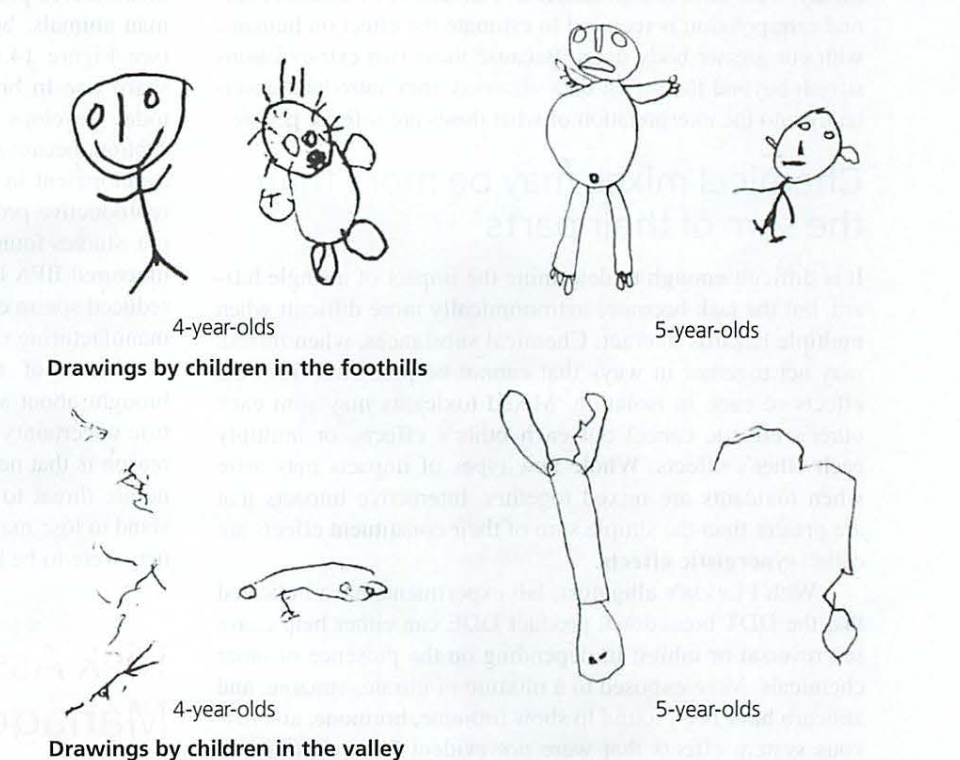
Synergistic effects-combined impact greater than sum of separate impacts, e.g. Endocrine disruptors
Risk probability: perception vs. reality
 Regulation: Innocent until proven guilty vs. precautionary principle
Regulation: Innocent until proven guilty vs. precautionary principle
 |
|
Click for full-size image |
Laws to know:
TOSCA 1976 in the US
REACH 2007 in EU (see difference below)

12 POPs: persistent organic pollutants: review for AP exam:
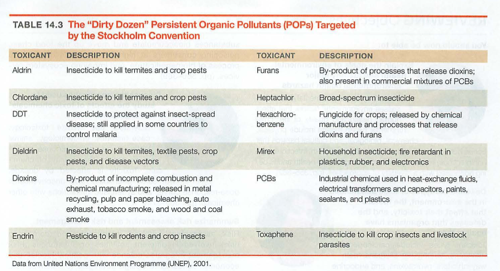 |
|
Click for full-size image |

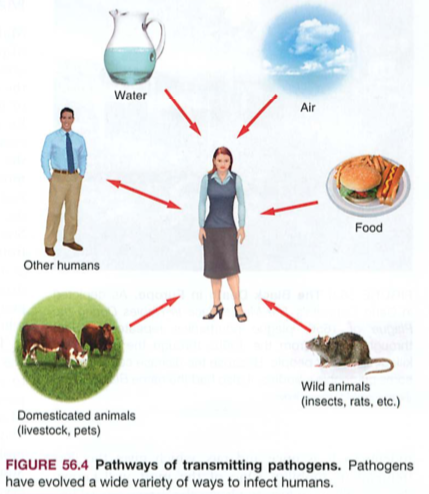












 Regulation: Innocent until proven guilty vs. precautionary principle
Regulation: Innocent until proven guilty vs. precautionary principle



Comments